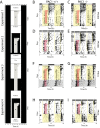Altered Circadian Food Anticipatory Activity Rhythms in PACAP Receptor 1 (PAC1) Deficient Mice
- PMID: 26757053
- PMCID: PMC4710526
- DOI: 10.1371/journal.pone.0146981
Altered Circadian Food Anticipatory Activity Rhythms in PACAP Receptor 1 (PAC1) Deficient Mice
Abstract
Light signals from intrinsically photosensitive retinal ganglion cells (ipRGCs) entrain the circadian clock and regulate negative masking. Two neurotransmitters, glutamate and Pituitary Adenylate Cyclase Activating Polypeptide (PACAP), found in the ipRGCs transmit light signals to the brain via glutamate receptors and the specific PACAP type 1 (PAC1) receptor. Light entrainment occurs during the twilight zones and has little effect on clock phase during daytime. When nocturnal animals have access to food only for a few hours during the resting phase at daytime, they adapt behavior to the restricted feeding (RF) paradigm and show food anticipatory activity (FAA). A recent study in mice and rats demonstrating that light regulates FAA prompted us to investigate the role of PACAP/PAC1 signaling in the light mediated regulation of FAA. PAC1 receptor knock out (PAC1-/-) and wild type (PAC1+/+) mice placed in running wheels were examined in a full photoperiod (FPP) of 12:12 h light/dark (LD) and a skeleton photoperiod (SPP) 1:11:1:11 h L:DD:L:DD at 300 and 10 lux light intensity. Both PAC1-/- mice and PAC1+/+ littermates entrained to FPP and SPP at both light intensities. However, when placed in RF with access to food for 4-5 h during the subjective day, a significant change in behavior was observed in PAC1-/- mice compared to PAC1+/+ mice. While PAC1-/- mice showed similar FAA as PAC1+/+ animals in FPP at 300 lux, PAC1-/- mice demonstrated an advanced onset of FAA with a nearly 3-fold increase in amplitude compared to PAC1+/+ mice when placed in SPP at 300 lux. The same pattern of FAA was observed at 10 lux during both FPP and SPP. The present study indicates a role of PACAP/PAC1 signaling during light regulated FAA. Most likely, PACAP found in ipRGCs mediating non-image forming light information to the brain is involved.
Conflict of interest statement
Figures



References
Publication types
MeSH terms
Substances
LinkOut - more resources
Full Text Sources
Other Literature Sources
Molecular Biology Databases
Research Materials
Miscellaneous

